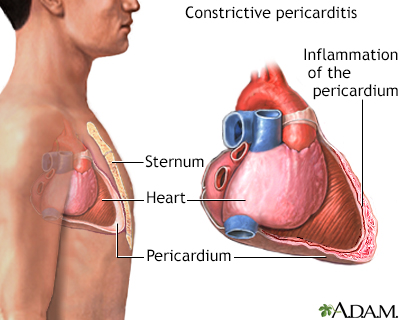Pregnancy SmartSiteTM
Constrictive pericarditis DefinitionConstrictive pericarditis is a process in which the sac-like covering of the heart (the pericardium) becomes thickened and scarred. Related conditions include:
 CausesMost of the time, constrictive pericarditis occurs due to things that cause inflammation to develop around the heart, such as:
Less common causes include:
The condition may also develop without a clear cause. It is rare in children.  SymptomsWhen you have constrictive pericarditis, the inflammation causes the covering of the heart to become thick and rigid. This makes it hard for the heart to expand properly when it beats. As a result, the heart chambers don't fill up with enough blood. Blood backs up behind the heart, causing heart swelling and other symptoms of heart failure. Symptoms of chronic constrictive pericarditis include:
Exams and TestsConstrictive pericarditis is very hard to diagnose. Signs and symptoms are similar to other conditions such as restrictive cardiomyopathy and cardiac tamponade. Your health care provider will need to rule out these conditions when making a diagnosis. A physical exam may show that your neck veins stick out. This indicates increased pressure around the heart. The provider may note weak or distant heart sounds when listening to your chest with a stethoscope. A knocking sound may also be heard. The physical exam may also reveal liver swelling and fluid in the belly area. The following tests may be ordered:
TreatmentThe goal of treatment is to improve heart function. The cause must be identified and treated. Depending on the source of the problem, treatment may include anti-inflammatory agents, antibiotics, medicines for tuberculosis, or other treatments. Diuretics ("water pills") are often used in small doses to help the body remove excess fluid. Pain medicines may be needed for discomfort. Some people may need to cut down on their activity. A low-sodium diet may also be recommended. If other methods do not control the problem, surgery called a pericardiectomy may be needed. This involves cutting or removing the scarring and part of the sac-like covering of the heart. Outlook (Prognosis)Constrictive pericarditis may be life threatening if untreated. However, surgery to treat the condition has a high risk for complications. For this reason, it is most often done in people who have severe symptoms. Possible ComplicationsComplications may include:
When to Contact a Medical ProfessionalContact your provider if you have symptoms of constrictive pericarditis. PreventionIn some cases, constrictive pericarditis is not preventable. However, conditions that can lead to constrictive pericarditis should be properly treated. ReferencesHoit BD, Oh JK. Pericardial diseases. In: Goldman L, Cooney KA, eds. Goldman-Cecil Medicine. 27th ed. Philadelphia, PA: Elsevier; 2024:chap 62. Jouriles NJ. Pericardial and myocardial disease. In: Walls RM, Hockberger RS, Gausche-Hill M, eds. Rosen's Emergency Medicine: Concepts and Clinical Practice. 10th ed. Philadelphia, PA: Elsevier; 2023:chap 68. Lewinter MM, Cremer PC, Klein AL. Pericardial diseases. In: Libby P, Bonow RO, Mann DL, Tomaselli GF, Bhatt DL, Solomon SD, eds. Braunwald's Heart Disease: A Textbook of Cardiovascular Medicine. 12th ed. Philadelphia, PA: Elsevier; 2022:chap 86. | |
| |
Review Date: 5/8/2024 Reviewed By: Thomas S. Metkus, MD, Assistant Professor of Medicine and Surgery, Johns Hopkins University School of Medicine, Baltimore, MD. Also reviewed by David C. Dugdale, MD, Medical Director, Brenda Conaway, Editorial Director, and the A.D.A.M. Editorial team. The information provided herein should not be used during any medical emergency or for the diagnosis or treatment of any medical condition. A licensed medical professional should be consulted for diagnosis and treatment of any and all medical conditions. Links to other sites are provided for information only -- they do not constitute endorsements of those other sites. No warranty of any kind, either expressed or implied, is made as to the accuracy, reliability, timeliness, or correctness of any translations made by a third-party service of the information provided herein into any other language. © 1997- A.D.A.M., a business unit of Ebix, Inc. Any duplication or distribution of the information contained herein is strictly prohibited. | |

 Pericardium
Pericardium Constrictive peric...
Constrictive peric...
